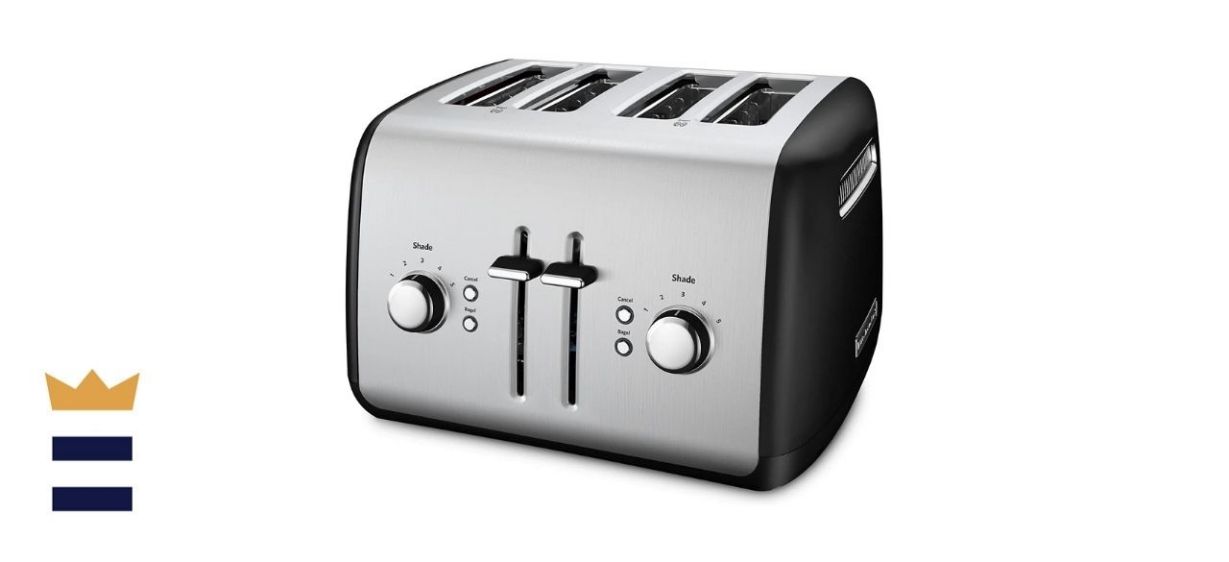4-slice toasters comparison
A toaster is an essential kitchen appliance for everything from breakfast pastries to BLTs. The right toaster can quickly produce perfectly toasted food for everyone in your household, but with the number of options to choose from, picking the best toaster can seem overwhelming.
To help narrow the field, we put two popular four-slice toasters to the test: the KitchenAid KMT4115OB and the Cuisinart CPT-435. Over a period of 2 weeks, we toasted bagels, slices of sourdough and more in these toasters to see which one came out on top. Here’s what we learned.
Key features to consider when shopping for a toaster
Given the simple tasks we associate with toasters, they offer a surprising amount of variety. First, you’ll need to choose whether you want two or four slices of bread toasted at a time. Four-slice toasters are great for larger families, and they let you customize the color on each pair of slices, but they may take up too much space for individuals or smaller households.
Next, think about what kind of food usually goes in your toaster. For example, if you love toasted bagels, you’ll want a toaster with wider slots to accommodate the thicker size. Finally, consider whether a stainless steel or colorful exterior fits in better with your kitchen decor.
Modern toasters offer small yet meaningful features to make food prep more convenient. These can include an LED or LCD timer, a lift to raise your toast out of the finger-scorching interior or a bagel-toasting setting that only heats one side of the toaster. Some toasters even offer a defrost setting that allows you to gently and evenly toast foods like frozen waffles straight from the freezer.
Finally, look for easy-to-remove crumb trays to help you keep your toaster clean and smoke-free. Depending on how often you use your toaster, it should be cleaned out weekly.
Toasters worth considering
Our experience with the KitchenAid KMT4115OB Toaster
The KitchenAid KMT4115OB toaster was simple to set up, and its five toast shade levels were easy to select. While some toasters can seem overloaded with features and options, this one felt streamlined and intuitive. The model we tested had a stainless steel body with black side panels, giving it a vintage appearance we appreciated.
Sold by Amazon.
Why we recommend the KitchenAid KMT4115OB Toaster
The KitchenAid toaster was easy to use and it delivered excellent results each time. All five shade levels provided distinctly different results. Both the standard toast setting and the bagel setting gave us evenly toasted bread and bagels.
At 8 pounds, it’s a little heavy, but its components felt sturdy and well-made. The controls felt weighty but still responsive and easy to operate. The toaster’s crumb trays, which pop out with the push of a button, are dishwasher-safe for thorough cleaning.
We also appreciated the built-in cord storage on the bottom of the toaster, which helped manage excess cord length and keep the counter tidy. The only downside we encountered during testing was the stainless steel’s tendency to pick up fingerprints.
What is the Cuisinart CPT-435 Toaster?
The modern style of the Cuisinart CPT-435 caught our eye right away. It’s priced similarly to the KitchenAid, but it offers LED digital controls and some settings and features that aren’t found on the KitchenAid. Most notable are its bright digital controls, which also offer a highly visible countdown timer.
The Cuisinart toaster boasts a “defrost” setting, which was useful for frozen treats like waffles. Its “reheat” setting is also handy for quickly warming up foods when you’re in a rush.
Sold by Amazon.
Why we recommend the Cuisinart CPT-435 Toaster
This toaster offers many more features and settings than the KitchenAid, so it’s a good idea to look through the user manual before you get started. We liked the contemporary appearance and the range of toasting settings, but overall, the Cuisinart’s toasting performance was not as consistent as the KitchenAid on higher heat settings. It also didn’t fit larger slices of bread as well as the KitchenAid. We weren’t big fans of the loud chime this toaster makes when food is done, but that feature could be useful in certain settings, like a larger house or workplace break room.
Like the KitchenAid, its stainless steel body is prone to fingerprints, but it also features a modern design and convenient cord storage. It has a larger footprint than the KitchenAid, but it weighs about a pound less. Its construction quality felt similar, but even with its additional features, the KitchenAid toaster emerged on top — though only by a hair. We were impressed with both toasters, and depending on your household size and technology preferences, either would make a convenient and reliable addition to your kitchen.
Sign up here to receive the BestReviews weekly newsletter for useful advice on new products and noteworthy deals.
Laura Duerr writes for BestReviews. BestReviews has helped millions of consumers simplify their purchasing decisions, saving them time and money.






